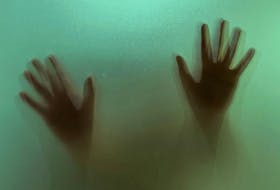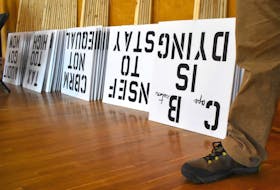There was an old lady who swallowed a fly.
Perhaps she’ll die.
Remember her?
Truth is, she probably wouldn’t have actually died from the fly — instead, she swallowed a spider to catch the fly, and on and on.
Keep that in mind as we consider a project you might call Muskrat Fish. (Why? Because it shows the fondness our governments have for huge projects, and for pushing those projects quickly through the regulatory process.)
Grieg NL proposed a massive Placentia Bay Atlantic salmon hatchery and grow-out operation. The project, the largest such project launched here, passed quickly through the province’s environmental assessment process, only to get bogged down in the courts after a ruling that the province shorted-circuited its own regulations to approve the project. That decision is now under appeal.
But back to the spider and the fly, and the question of whether the provincial government is the right one to regulate a project it clearly loves.
Think about one small part of the project: sea lice are a huge problem for salmon farms. Proliferating lice on concentrated penned salmon hurt productivity and lower the final value of the fish — but the use of chemicals to control sea lice is unpopular.
So enter the spider.
Grieg NL wants to use another kind of fish as a “cleaner fish” to conquer the lice problem.
“Sea lice will be managed using lumpfish (Cyclopterus lumpus) at 15 fish per 100 smolt. They require continuously clean nets to be effective. This will be a very significant transfer of Norwegian technology and pest management tools,” Grieg says in its environmental assessment registration.
There’s only one other mention of that protocol: a paragraph that reads: “Cleaner fish such as lumpfish will be used for sea lice control. Vaccines as they become available for deterrence of sea lice will also be used. Functional feeds will also be used to help manage sea lice. Only as a last resort will therapeutants be used to control sea lice. Animal welfare will not be compromised.”
But there issues you’d think government regulators would be curious about. A ratio of one lumpfish to every 15 salmon smolt would mean the facility would need more than a million fish — 1,050,000 lumpfish, to be exact — every year. (For biosecurity reasons, the cleaner fish are killed when individual salmon pens are harvested.)
Where would they come from?
The lumpfish population off Newfoundland and Labrador is, first of all, something of a cipher, with fisheries scientists saying, “Overall trends in common lumpfish population size in the Northwest Atlantic Ocean are generally unknown.” And what is known about the species is enough to have it designated in November as a threatened species — in fact, it even met the federal criteria for being labelled an endangered species, in part because of a decline of abundance of 58 per cent in the last two decades.
Perhaps Grieg intends, as aquaculture operations do in other countries, to use wild fish as broodstock for a lumpfish hatchery. After all, 26 million parasite-eating fish were used in the aquaculture industry in Norway in 2015.
But if they do, how would they ensure the broodstock isn’t carrying disease? They didn’t answer that. Perhaps they intend to import lumpfish broodstock. They didn’t say anything about that in their environmental registration. And they didn’t talk about the appearance of health issues with breeding lumpfish.
As research from last March in the journal “Reviews in Aquaculture” pointed out, “It is not known to what extent lumpfish are susceptible to diseases listed in current aquatic animal health regulations, and this needs to be reviewed as a risk to the developing cleaner fish industry.” A Norwegian committee on fisheries health pointed out in December that, “The disease status of wild-caught cleaner fish is, in general, poorly known. Translocations of such fish may result in the introduction of new pathogens to farmed salmonids.”
There may be problems — there may not.
The provincial government apparently had no questions about the lowly lumpfish solution, and where those fish, or their broodstock, might be coming from. That didn’t change until this week, well after the court action.
And that old lady? Eventually, she died.
Russell Wangersky can be reached at [email protected] — Twitter: @wangersky.








